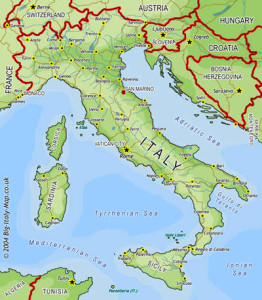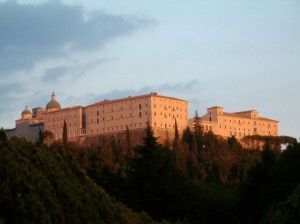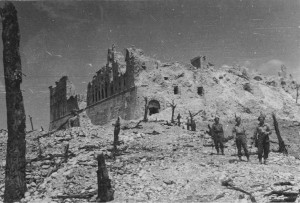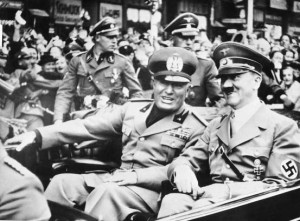Italy 1943/1944 – A Hard Slog
Roger Stanton
Following recent discussions about Italy and the Italian Campaign it has become evident that the problems experienced during the campaign and the difficulties for the escapers and evaders in Italy have not been fully appreciated. The campaign was totally overshadowed by events in Europe. Following the 70th anniversary of the breakout from the camps I thought it may be useful to offer an overview of the situation.
General Background
Western Europe was the Allies’ main objective at that time, and much of the fighting in Italy was of secondary importance. The Allies landed in southern Italy in early September 1943 following the signing of the Italian Armistice on the 3rd September. There is little doubt that the Allies expected the Germans to withdraw to the north of Italy, and not to have to fight their way up the Italian peninsula. As a result, the Italian theatre had to make do with reduced resources, both in terms of manpower and equipment, and in particular shipping and landing craft, which was to have serious implications for future operations.  In terms of Allied and Italian lives the war in Italy was very costly; the terrain was hostile to attacker and defender alike and Italy took a neutral stance regarding weather. Both sides suffered searing temperatures, high mountains, freezing winters, heavy snow, rain, swollen rivers to cross and often deep mud which brought even the best tracked vehicles to a halt. The winter of 1943-44 saw both sides endure the most applling weather. Roads were often non-existent. Very few maps existed and at times battlefields resembled the Somme. The majority of the hard and gruelling fighting took place in hostile mountain terrain.
In terms of Allied and Italian lives the war in Italy was very costly; the terrain was hostile to attacker and defender alike and Italy took a neutral stance regarding weather. Both sides suffered searing temperatures, high mountains, freezing winters, heavy snow, rain, swollen rivers to cross and often deep mud which brought even the best tracked vehicles to a halt. The winter of 1943-44 saw both sides endure the most applling weather. Roads were often non-existent. Very few maps existed and at times battlefields resembled the Somme. The majority of the hard and gruelling fighting took place in hostile mountain terrain.
 The Commonwealth War Grave cemeteries in Italy are vast, a testament to the ferocity of the fighting. For example the battle to capture Cassino began in mid January 1944. The objective was finally secured in mid-May, after four separate assaults and accounted for over 55,000 Allied casualties [many from the Polish Corps].Cassino After The final defeat of the German paratroopers, following a horrendous blood-bath, only came about because of a lack of ammunition.
The Commonwealth War Grave cemeteries in Italy are vast, a testament to the ferocity of the fighting. For example the battle to capture Cassino began in mid January 1944. The objective was finally secured in mid-May, after four separate assaults and accounted for over 55,000 Allied casualties [many from the Polish Corps].Cassino After The final defeat of the German paratroopers, following a horrendous blood-bath, only came about because of a lack of ammunition.
 At the same time the Italian Resistance and Partisan groups suffered badly as a result of operations by both the German military and by opposing Fascist groups. Many of their outstanding achievements and heroes went un-noted by the Allies – the priority was Western Europe and the surrender of Germany.
At the same time the Italian Resistance and Partisan groups suffered badly as a result of operations by both the German military and by opposing Fascist groups. Many of their outstanding achievements and heroes went un-noted by the Allies – the priority was Western Europe and the surrender of Germany.
In 1922 Benito Mussolini and his Fascist party effectively seized power by marching on Rome. Although a friend of Adolf Hitler, Mussolini did not enter the Second World War until 10 June 1940 when Hitler had taken over most of the Low Countries and Paris had fallen to the German Army. In Italy a number of infrastructure projects such as roads, railways, irrigation of the land and plans to eradicate mosquitos in the south of the country had been successful; but to most Italians, particularly the mountain people or ‘contadini’, there was little interest in fascism and the war in Western Europe. The communists and Royalists were another matter.
Although a friend of Adolf Hitler, Mussolini did not enter the Second World War until 10 June 1940 when Hitler had taken over most of the Low Countries and Paris had fallen to the German Army. In Italy a number of infrastructure projects such as roads, railways, irrigation of the land and plans to eradicate mosquitos in the south of the country had been successful; but to most Italians, particularly the mountain people or ‘contadini’, there was little interest in fascism and the war in Western Europe. The communists and Royalists were another matter.
The ‘contadini’ of the mountains were tied to a feudal system of landlords, hardly ever left their villages and had very little interest in politics; news reached them by word of mouth from other villages. Their main concerns were their animals and their harvest. As most of Italy is very mountainous and rugged, even today parts are still not mapped correctly, so early European travellers seldom headed up into the mountain regions, thus maintaining the anonymity of the ‘contadini’ and their villages. This was about to change.
By August 1943 the International Red Cross had registered over 84,000 Allied PoWs in Italy. This covered not only Allied soldiers, sailors and airmen but also ancillary workers such as NAAFI personnel, Cypriots, Egyptians, Greeks and many other people working for the Allied cause. Most PoWs had been captured in North Africa, but others had been transferred from camps in the South of France when the Germans occupied the Vichy area. In November ‘42, soon after the conclusion of Operation Torch (the Allied landings in North Africa) Hitler Hitler ordered the disbandment of the French Armistice Army following a dispute about French cooperation with the Allies in North Africa. Following the occupation PoWs were collected by Italian troops and taken to PoW camps in Italy. On one convoy leaving Saint-Hippolyte-du-Fort on December 06 1942, one hundred guards were required to escort the men to PG5 at Gavi, and PG73 at Modena. The convoy lost a number of escapers en route before it even reached Grenoble. When it stopped later to replenish fuel and water a Capt Brown left by the back door of the bus and sprinted off into a wood. Given assistance and food at farmhouses en route he reached Grenoble and later Marseille, before being taken into Spain and later Gibraltar.
Situation Following the Armistice
On 8th September 2013 we commemorated the 70th anniversary of the Italian Armistice. Although the Armistice was signed on the 3rd September 1943 and announced on the 8th, many of the PoW camps in areas that were mountainous, wild and quite remote, did not receive the initial signal until up to two weeks later, so were unaware of the changed situation. An Allied instruction had been issued informing all Senior British Officers (SBOs) to keep PoWs in their camps and to await the arrival of Allied forces. An easy Allied advance from the beachheads northwards had been predicted, but was thwarted! The Germans reinforced northern and central Italy and prepared defences in depth. It soon became apparent that common sense had to prevail and that if swift action was not taken there was a likelihood of the PoWs being moved out of the camps to new camps and work camps in Germany. Many of the Italian camp guards fled leaving some camps under the control of the SBOs. Others had been ordered to continue guarding the prisoners until the Germans arrived. A number of SBOs refused to allow POWs to leave the camps. Others, like the SBO at Fontanellato, used the military communication system of bugles to call the men out on parade equipped with pre-packed small packs; once in company formations they were marched out of camp by the SBO. At Servigliano, the guards dutifully continued to man the one main gate while turning a ‘blind eye’ to the prisoners as they made a hole in the rear stone wall and escaped into the surrounding countryside. A number of northern camps were quickly -occupied by the Germans resulting in their prisoners being moved to Germany. After the war, following complaints from the rank and file, a number of SBOs who had not allowed their men to escape were disciplined. It is estimated that about 55,000 men escaped into the rugged mountainous areas, although most were rounded up by German Alpine troops and transported onwards to Germany.
As winter approached, life on the run in the woods and mountains became less appealing. The escapers quickly learned the art of survival: sleep in the warm midday sun and walk at night to keep warm; head for the very small farms in states of disrepair; avoid the large farms in good condition – they were likely to be fascist; seek out charcoal burners in the forest areas at night when their fires were less visible; find caves where fires could be started but not be visible. As the winter weather became colder food sources became scarce. The evaders were at risk of capture from not only the German troops but also from the fascists seeking rewards for ‘bounty hunting’. Many escapers met up with Resistance and Partisan groups, who in most cases were no better off than they were; their footwear was worn out and their clothing in tatters. Many had stolen weapons and were carrying on the fight. The escapers who joined up with these groups often taught the young fighters tactics and weaponry.
Although posters were displayed in villages and towns warning people about the harsh consequences of sheltering the enemy – farms burned to the ground, livestock slaughtered, harsh interrogations followed by torture and deportation to a concentration camp in Germany for complete families, execution – the contadini of the mountains, who had hardly enough food for themselves, were willing to share what they had with strangers, in the name of humanity. So it was to the small isolated farms that many escapers turned to for help – very few escapers were turned away, even though it was known that the Germans put English speaking soldiers into the mountains to discover the whereabouts of the safe-houses and villages.
Many escapers would eat in the family farms at night, then be taken (usually by young children) to a cave or barn in the hills to hide during daylight hours. Others, as payment for their medical care, food and shelter, chose to work on the farms for a short period before moving on. (Most of the pre-war Italian farm-hands had been conscripted into the Italian army and, paradoxically, were now POWs themselves in England, Canada and the USA!) Many ‘helpers’ were caught and paid an appalling cost. Winston Churchill wrote in his ‘History of the Second World War’: ‘over 10,000 PoWs in German occupied Italy were fed, hidden and guided by the Italian people, often the poorest from the Italian countryside. Many were shot for this great spontaneous gesture of humanity’. There were many brave deeds carried out in Italy that have never been rewarded.
In the village of Pietransieri, in the Sulmona valley, the entire population of 129, except for one small child were massacred by the Germans,. Their crime had been to provide assistance to evaders. The villagers had actually managed to ‘evacuate’ the evaders just as the Germans arrived; they had been betrayed by collaborators.
Evasion in Italy was very different from that in other areas of Europe. There were no established escape lines, the country was surrounded on three sides by the sea and had only one mountainous land border to the north which was often impossible during winter conditions. There were many independent British units operating in the country. Apart from the Partisans and Italian Resistance, irregular units included: Popski’s Private Army, the Long Range Desert Group, Commandos, Phantom Squadrons, Raiding Forces, SAS, SBS, SIG (Special Interrogation Group, which was a German Jewish group often operating in German uniforms), Parachute Brigade, SOE, OSS, 1 Special Force, IS9, ‘A’ Force. The enemy also had allies in small groupings, particularly mountain and ski troops from Eastern Europe, Fascists in Italy and SS Legions from most of the German occupied territories. Never before or after Italy had so many irregular units operated in one campaign. Many evaders linked up with these groups.
The British Army was equally as diverse, every Commonwealth country was involved. Indians, Ghurkhas, Sikhs, Hindus. Moslems, South Africans, New Zealanders and Maoris, Australians, Canadians, an Army Corps from Poland. Soldiers from Africa and the West Indies, every ethnic group and religion were represented, including a Palestinian Jewish Brigade. The Americans also included in their front-line forces a Negro Division. There were also Italian Americans and Senegalese, Moroccans, and North African Arab tribes which were all part of the French Colonial Forces. There were Hellenic Greeks, Cypriots and Egyptians. The British had ‘Free Forces’ from nearly all of the European countries in their units. By far the most dangerous to everyone were the irregular Moroccan Goumiers with the French Colonial Forces. Paid as mercenaries, they beheaded, looted and raped their way through Italy. Many were mounted on horses and it was thought they had a pact with their colonial masters. Despite complaints from the British and Americans well over 3000 women were attacked, although many did not report it, and many were killed.
From a military perspective radio traffic must have been very, very difficult. Often, in order to speak in ‘plain speech’ rather than use code, many troops spoke in Ghurkhali, Basque, Gallic, Maori and other less familiar languages. The American Army used Indian tribal dialects for radio security; crypto and code systems don’t bear thinking about! I understand that in Normandy most radio traffic was in English.
Into this environment, in September 1943, walked the escapers. No official networks for escapers existed although a network in Rome, ran by Monseigneur Hugh O’Flaherty hid escapers all around Rome and smuggled maps and currency into the camps. Known as the Scarlett Pimpernel, O’Flaherty was a life line to men on the run. He is acknowledged with having assisted more than 4000 evaders/escapers. He was a very large man, easily recognised, and was eventually denounced to the Gestapo so continued his work from within the safe confines of the Vatican City. On many occasions, assisted by his helpers, he also continued with his work outside.
In the lower levels of the Alps, an organisation, ran by Giuseppe Bacciagaluppi in the border areas, also delivered many hundreds of evaders into Switzerland. In the North West an International Partisan Brigade organised by escaper Major Gordon Lett worked alongside the SAS and SOE. The SAS had their own extraction and supply route to the coast, known as the Ferrovia route which has been credited with 800 PoW extractions and was ran by the legendary partisan leader Lt Danny Buchionni (ELMS member and now a General with an OBE. Sadly General Buchionni died in 2014.).
The story of Michele del Greco
On a very hot day in 2002, I had walked with many other people from Sulmona, stopped at the town of Bugnara en route and then crammed into the town hall of Anversa for a memorial service to the shepherd Michele Del Greco. To most members he was an unknown name; to me he was one of the many heroes of the escape routes in Italy who had died for the men he helped. He did not know them and could not speak their language. Finally, nearly sixty years after all he had done, a memorial plaque was unveiled to Michele’s memory.
Michele was a shepherd, a quiet family man who lived in Anversa. He knew the Abruzzi mountains well, kept his sheep in the high pastures then brought them down for the winter. After September ‘43 he met many escapers who needed help. At great risk to himself and his family Michele brought them food, provided shelter in the roofed sheepfolds and bothies and organised medical care when needed. He also used his home as a safe-house. He guided them over the mountains, nearly always south to the Sangro River, avoiding areas he had spotted where German troops were located. He rode his horse for miles looking for escapers.
On all escape lines throughout Europe the Germans planted English-speaking Germans to infiltrate the lines. The contadini were no exception and Germans infiltrated their routes. Michele was a gentle, friendly man who did not have any training for this type of work. He was easy prey. On one occasion he assisted two men down to the Sangro River only to have one of them return days later with a colleague, both dressed as German officers. They arrested Michele while he was tending his sheep. While receiving the hospitality of the del Greco family the German officer had signed a notebook containing many names of evaders – he now demanded this book. Michele denied he had one. He was taken home; the Germans ransacked his house looking for it. It was eventually found and contained fifty-six names. Many escapers had not signed the book because they thought it would compromise Michele but it is thought that over one hundred and fifty were assisted on their way south by the family. Michele was charged with assisting enemy prisoners to escape and taken to the civilian prison at Badia.
Michele’s family were informed that he was to be charged to set an example to others. In court in Sulmona he was unable to understand the proceedings that were in German. His barrister stated that he was an honest, ignorant man, a poor shepherd who had acted in good faith and humanity but Michele was condemned to death. On the same day, the following was posted on the walls of the town of Anversa:
“The German Military Authority has condemned to death Michele del Greco, Shepherd, of 47 years, for having sheltered about 56 English, French, Russian, American POWs escaped from concentration camps.”
The Del Greco family found themselves isolated in their own community. The local people were all scared of the Germans and what they may do to them if they communicated with the family. The Germans shot and took away the family animals and pets. Their house was burnt down with everything in it – they were in the depths of winter. Strangely, it was the German soldiers based in Anversa who took pity on the family. One soldier visited them and took a letter requesting an amnesty which was given to the barrister. The soldier also arranged for permits for the family to visit. It is also thought they helped them with food. Michele was respected by Germans and Italians alike. The execution was delayed, Christmas was approaching and the family expected him to be released but Michele del Greco was executed by firing squad on the 22nd December 1943, one month after his arrest.
In Italy most of the escapers tended to head south to cross the Sangro River and the Allied lines, although a much smaller number headed north to Switzerland, where, once in Switzerland escapers found that they could not leave the country because of its neutrality, so had to report to police stations daily. With that in mind, others immediately attempted to head into France through the border fence and eventually make contact with an escape line and to take them over the Pyrenees. The route into Switzerland is very difficult and under winter conditions is extremely hostile. In October ‘43, 29 evaders took on the route over the Alps. The situation became desperate. Faced with severe blizzards, freezing temperatures and many avalanches only two men reached the Swiss border. Both men were in difficulties suffering from gangrene, frostbite and hypothermia. The rest had died in the mountains.
During a trail in 2001 we had walked to a small village and were resting, when a support Land Rover arrived carrying two of our veteran escapers. They had stayed in the village in the winter of 43/44 and starting exploring the far end of the village, where they had been hidden, to try and find anyone who remembered them. After they had left, I was joined by an elderly contadini lady who showed me a very old black and white photograph of three young men in civilian clothing. Brian Lett, an Italian speaker, discovered that the lady wanted to know if we knew these men. She had last seen them in 43/44 and the photo indicated they were then about nineteen. On turning the photo over we found three misspelt, pencilled names. Two of the men mentioned had just left us to walk to the other end of the village to find the same lady! She got into the Land Rover in tears to be driven to the other side of the village where she had previously lived. Following an emotional reunion the men requested to stay in the village overnight. When I suggested that they had no overnight kit, they responded with ‘We walked in with no kit last time!’
(Additional Information on Michele Del Greco from his daughter Raffaella Del Greco)
